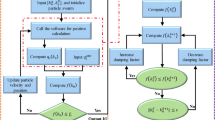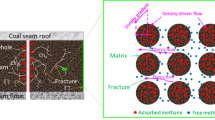Abstract
Rapid and accurate acquisition of permeability and gas pressure is crucial for gas development and disaster prevention in coal mines. However, these two parameters are currently challenging to obtain simultaneously using traditional testing methods. Moreover, due to the theoretical basis of the radial flow equation, most methods are only applicable to cross-seam borehole, which brings great limitations to the application of the methods. Therefore, this paper derives a new dual porosity/dual permeability model considering the impacts of time-dependent Fick diffusion, matrix mechanical and sorption strain. According to this coupling model and the surrogate optimization (SO) algorithm, a synchronous inversion method of the gas pressure and permeability is suggested. Then, the dependability of this method is validated by field tests. The findings demonstrate that, in contrast to other theoretical models and optimization algorithms, the new model can more precisely depict the actual change of borehole gas flow, and the SO algorithm can find a global optimal solution with higher accuracy in less time. Compared with traditional methods, the new method has the advantages of strong universality, short testing cycle and high automatic level. Therefore, this method has the potential to be an effective tool for obtaining coal seam gas parameters.



















Similar content being viewed by others
Notes
* 1 mD = 1 millidarcy = 9.869233−16 m2
References
Bandyopadhyay, K., Mallik, J., Shajahan, R., & Agarwal, N. (2020). Closing the gap between analytical and measured coal permeability. Fuel, 281, 118752.
Banerjee, A., & Chatterjee, R. (2021). A methodology to estimate proximate and gas content saturation with lithological classification in coalbed methane reservoir, Bokaro field, India. Natural Resources Research, 30, 2413–2429.
Cui, X., Zhang, J., Guo, L., Gong, X., & Xia, B. W. (2020). A new method for the measurement of gas pressure in water-bearing coal seams and its application. Geofluids, 2020, 1–11.
Dutka, B. (2021). Effect of depth on the sorption capacity of coals affected by outburst hazard. Fuel, 306, 121611.
Gutmann, H. M. (2001). A radial basis function method for global optimization. Journal of Global Optimization, 19, 201–227.
Hosking, L. J., & Thomas, H. R. (2020). Dual porosity modelling of coal core flooding experiments with carbon dioxide. Computers and Geotechnics, 121, 103454.
Kong, X., Wang, E., Liu, Q., Li, Z., Li, D., Cao, Z., & Niu, Y. (2017). Dynamic permeability and porosity evolution of coal seam rich in CBM based on the flow-solid coupling theory. Journal of Natural Gas Science and Engineering, 40, 61–71.
Kumar, H., Elsworth, D., Mathews, J. P., Liu, J., & Pone, D. (2014). Effect of CO2 injection on heterogeneously permeable coalbed reservoirs. Fuel, 135, 509–521.
Lin, M., Lin, B., Yang, W., Zhao, Y., & Wang, Z. (2022). In-situ testing method of the permeability coefficient in a coal seam based on the finite volume method and its application. Journal of Natural Gas Science and Engineering, 97, 104370.
Liu, J., Chen, Z., Elsworth, D., Miao, X., & Mao, X. (2010). Evaluation of stress-controlled coal swelling processes. International Journal of Coal Geology, 83, 446–455.
Liu, J., Qin, Y., Zhou, T., & Gao, Y. (2020a). Dual-porosity coupled borehole gas flow model: A new method for inversion of coal seam permeability. Natural Resources Research, 29(6), 3957–3971.
Liu, J., Wang, J., Chen, Z., Wang, S., Elsworth, D., & Jiang, Y. (2011). Impact of transition from local swelling to macro swelling on the evolution of coal permeability. International Journal of Coal Geology, 88, 31–40.
Liu, P., Fan, L., Li, Q., & Zhong, F. (2022a). Power ultrasound assisted coalbed methane enhancement recovery: Field application and performance evaluation in underground coal mine. Fuel, 324, 124575.
Liu, P., Liu, A., Liu, S., & Qi, L. (2022b). Experimental evaluation of ultrasound treatment induced pore structure and gas desorption behavior alterations of coal. Fuel, 307, 121855.
Liu, P., Liu, A., Zhong, F., Jiang, Y., & Li, J. (2021). Pore/fracture structure and gas permeability alterations induced by ultrasound treatment in coal and its application to enhanced coalbed methane recovery. Journal of Petroleum Science and Engineering, 205, 108862.
Liu, P., Nie, B., Zhao, Z., Zhao, Y., & Li, Q. (2023a). Characterization of ultrasonic induced damage on multi-scale pore/fracture in coal using gas sorption and μ-CT 3D reconstruction. Fuel, 332, 126178.
Liu, Q., Cheng, Y., Haifeng, W., Hongxing, Z., Liang, W., Wei, L., & Hongyong, L. (2015). Numerical assessment of the effect of equilibration time on coal permeability evolution characteristics. Fuel, 140, 81–89.
Liu, Q., Chu, P., Zhu, J., Cheng, Y., Wang, D., Lu, Y., Liu, Y., Xia, L., & Wang, L. (2020b). Numerical assessment of the critical factors in determining coal seam permeability based on the field data. Journal of Natural Gas Science and Engineering, 74, 103098.
Liu, Q., Li, Z., Wang, E., Niu, Y., & Kong, X. (2020c). A dual-permeability model for coal under tri-axial boundary conditions. Journal of Natural Gas Science and Engineering, 82, 103524.
Liu, T., & Lin, B. (2019). Time-dependent dynamic diffusion processes in coal: Model development and analysis. International Journal of Heat and Mass Transfer, 134, 1–9.
Liu, T., Lin, B., & Yang, W. (2017). Impact of matrix–fracture interactions on coal permeability: Model development and analysis. Fuel, 207, 522–532.
Liu, Y., Lebedev, M., Zhang, Y., Wang, E., Li, W., Liang, J., Feng, R., & Ma, R. (2022c). Micro-cleat and permeability evolution of anisotropic coal during directional CO2 flooding: An in situ Micro-CT study. Natural Resources Research, 31, 2805–2818.
Liu, Y., Wang, E., Li, W., Jiang, C., Zhang, D., Li, M., Yu, B., & Zhao, D. (2023b). True triaxial experimental study of anisotropic mechanical behavior and permeability evolution of initially fractured coal. Natural Resources Research, 32(2), 567–585.
Mamunya, L. A. (1975). A problem of gas pressure prediction. Soviet Automatic Control, 8, 62–65.
Peng, Y., Liu, J., Wei, M., Pan, Z., & Connell, L. D. (2014). Why coal permeability changes under free swellings: New insights. International Journal of Coal Geology, 133, 35–46.
Ramandi, H. L., Mostaghimi, P., & Armstrong, R. T. (2017). Digital rock analysis for accurate prediction of fractured media permeability. Journal of Hydrology, 554, 817–826.
Regis, R. G., & Shoemaker, C. A. (2007). A stochastic radial basis function method for the global optimization of expensive functions. INFORMS Journal on Computing, 19, 497–509.
Skiba, M., Dutka, B., & Młynarczuk, M. (2021). MLP-based model for estimation of methane seam pressure. Energies, 14, 7661.
Thararoop, P., Karpyn, Z. T., & Ertekin, T. (2012). Development of a multi-mechanistic, dual-porosity, dual-permeability, numerical flow model for coalbed methane reservoirs. Journal of Natural Gas Science and Engineering, 8, 121–131.
Wang, F., Ren, T., Tu, S., Hungerford, F., & Aziz, N. (2012a). Implementation of underground longhole directional drilling technology for greenhouse gas mitigation in Chinese coal mines. International Journal of Greenhouse Gas Control, 11, 290–303.
Wang, H., Wang, E., Li, Z., Shen, R., Liu, X., Zhang, Q., & Li, B. (2020). Study and application of dynamic inversion model of coal seam gas pressure with drilling. Fuel, 280, 118653.
Wang, H., Xian, X., Yin, G., Zhang, R., Yang, J., & Tang, J. (1999). Investigation of analytic method for coalbed gas pressure in high temperature and deeply mining mines. Journal of China Coal Society, 24, 279–283. in Chinese.
Wang, L., Cheng, Y., Wang, L., Guo, P., & Li, W. (2012b). Safety line method for the prediction of deep coal-seam gas pressure and its application in coal mines. Safety Science, 50, 523–529.
Wang, X., Cheng, Y., Zhang, D., Yang, H., Zhou, X., & Jiang, Z. (2021). Experimental study on methane adsorption and time-dependent dynamic diffusion coefficient of intact and tectonic coals: Implications for CO2-enhanced coalbed methane projects. Process Safety and Environmental Protection, 156, 568–580.
Wei, Z., & Zhang, D. (2010). Coupled fluid-flow and geomechanics for triple-porosity/dual-permeability modeling of coalbed methane recovery. International Journal of Rock Mechanics and Mining Sciences, 47, 1242–1253.
Wu, Y., Liu, J., Elsworth, D., Chen, Z., Connell, L., & Pan, Z. (2010). Dual poroelastic response of a coal seam to CO2 injection. International Journal of Greenhouse Gas Control, 4, 668–678.
Xia, T., Zhou, F., Liu, J., & Gao, F. (2014). Evaluation of the pre-drained coal seam gas quality. Fuel, 130, 296–305.
Zhang, C., Wang, E., Li, B., Kong, X., Xu, J., Peng, S., & Chen, Y. (2023). Laboratory experiments of CO2-enhanced coalbed methane recovery considering CO2 sequestration in a coal seam. Energy, 262, 125473.
Zhang, H., Liu, J., & Elsworth, D. (2008). How sorption-induced matrix deformation affects gas flow in coal seams: A new FE model. International Journal of Rock Mechanics and Mining Sciences, 45, 1226–1236.
Zhang, S., Liu, J., Wei, M., & Elsworth, D. (2018). Coal permeability maps under the influence of multiple coupled processes. International Journal of Coal Geology, 187, 71–82.
Zhao, W., Cheng, Y., Jiang, H., Wang, H., & Li, W. (2017). Modeling and experiments for transient diffusion coefficients in the desorption of methane through coal powders. International Journal of Heat and Mass Transfer, 110, 845–854.
Zhao, W., Cheng, Y., Pan, Z., Wang, K., & Liu, S. (2019). Gas diffusion in coal particles: A review of mathematical models and their applications. Fuel, 252, 77–100.
Zhi, S., & Elsworth, D. (2016). The role of gas desorption on gas outbursts in underground mining of coal. Geomechanics and Geophysics for Geo-Energy and Geo-Resources, 2, 151–171.
Zhou, R., & Yan, B. (2016). Research on calculating gas pressure with gas flow in crossing borehole. Chinese Journal of Rock Mechanics and Engineering, 35, 3147–3152. (in Chinese).
Zhou, S. (1980). Measurement and calculation of coal seam permeability coefficient. Journal of China Institute of Mining and Technology, 1, 1–5. (in Chinese).
Zou, M., Wei, C., Yu, H., & Song, L. (2015). Modeling and application of coalbed methane recovery performance based on a triple porosity/dual permeability model. Journal of Natural Gas Science and Engineering, 22, 679–688.
Acknowledgments
This work was supported by the National Key R&D Program of China (2022YFC3004705), National Natural Science Foundation of China (52004267, 52074280), Key Projects of National Natural Science Foundation of China (51934007), China Postdoctoral Science Foundation (2020M672235) and Science and Technology Planning Project of Guizhou Province, China (No. [2023] General 279).
Author information
Authors and Affiliations
Corresponding author
Ethics declarations
Conflict of Interest
The authors declare that they have no known competing financial interests or personal relationships that could have appeared to influence the work reported in this paper.
Rights and permissions
Springer Nature or its licensor (e.g. a society or other partner) holds exclusive rights to this article under a publishing agreement with the author(s) or other rightsholder(s); author self-archiving of the accepted manuscript version of this article is solely governed by the terms of such publishing agreement and applicable law.
About this article
Cite this article
Liu, Q., Li, Z., Wang, E. et al. Synchronous Inversion of Coal Seam Gas Pressure and Permeability Based on a Dual Porosity/Dual Permeability Model and Surrogate Optimization Algorithm. Nat Resour Res 32, 2115–2136 (2023). https://doi.org/10.1007/s11053-023-10236-x
Received:
Accepted:
Published:
Issue Date:
DOI: https://doi.org/10.1007/s11053-023-10236-x




